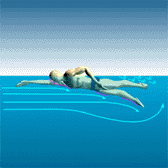Don't Make Waves
 Fast and slow swimming pools? What are they? A given pool's walls and other components may create and reflect waves making it more difficult (slow) for athletes to swim. A fast pool minimizes wave interference with the athletes making it easier (fast) for the athletes to swim.
Fast and slow swimming pools? What are they? A given pool's walls and other components may create and reflect waves making it more difficult (slow) for athletes to swim. A fast pool minimizes wave interference with the athletes making it easier (fast) for the athletes to swim.
There are different types of waves which move matter differently. When you toss a small stone into a body of water, waves are formed from the point the stone hit the water. The waves form a circular pattern around this entry point and spread farther and farther apart in a single wave pattern. When you look at these waves, you can see the crests (high points) and troughs (low points). Only a few crests and troughs are created. But when you drop 2 or 3 stones into the water at the same time, you have more waves and these waves interact with one another.
Imagine 8 lanes of Olympic swimmers! Each swimmer's motion generates a series of waves. These waves can move across the lanes and interact with one another and against the athletes in different directions, making it more difficult to swim and slowing down the athletes' times. Have you ever had to walk into the wind? It's more difficult than on a calm day. Similarly, swimming into waves is more difficult than swimming in calm water. The water in fast Olympic pools 'spills over' the walls of the pools. This minimizes wave reflection and interference.
About the Author
Gene Mascoli, JD
 Gene Mascoli is a founder and publisher of ScienceIQ.com. He holds a J.D. degree from the University of Santa Clara and a B.A. in English. In 1997 Gene launched ScienceMaster.com, an online science education portal where he brought together his love of writing with his interest in the sciences. Gene collaborated with David Gamon on the popular digital book
“The Internet Guide to NASA on the Net” and has also produced two popular science CD-ROMs on astronomy and space science.
Gene Mascoli is a founder and publisher of ScienceIQ.com. He holds a J.D. degree from the University of Santa Clara and a B.A. in English. In 1997 Gene launched ScienceMaster.com, an online science education portal where he brought together his love of writing with his interest in the sciences. Gene collaborated with David Gamon on the popular digital book
“The Internet Guide to NASA on the Net” and has also produced two popular science CD-ROMs on astronomy and space science.


